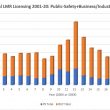Narrowbanding generates flurry of activity for frequency coordinator
This week's FCC narrowbanding deadline resulted in an "unprecedented" number of applications being filed with the Enterprise Wireless Alliance (EWA), according to Mark Crosby, the president/CEO of the frequency-coordination organization.
"In my years, this is busiest we've been," Crosby said yesterday during an interview with Urgent Communications. "In terms of pieces of paper, it's probably the biggest of all time. I would guess that, for anyone in this business, [2012] will be a year that will never occur again."
Under the FCC's narrowbanding mandate, LMR systems operating on spectrum below 512 MHz — effectively 470 MHz, after the agency granted a waiver to systems operating on T-Band spectrum — were required to make the transition from 25 kHz channels to 12.5 kHz channels by the end of 2012.
As the deadline neared, the number of applications to alter licenses in a manner that reflects the narrowband change to LMR system increased, Crosby said. Just last week, EWA received "at least" 500 applications from business/industrial operators and another 200 applications from public-safety agencies trying to comply with the narrowbanding mandate, he said.
"It's sort of unprecedented," Crosby said.
Still more applications were filed over the weekend and on Monday, the final day for licensees to meet the narrowbanding deadline, but Crosby said that he did not have figures for those days at the time of the interview.
Last month, both the FCC wireless-telecommunications and homeland-security bureaus informed the Land Mobile Communications Council (LMCC) that licensees could meet the narrowbanding mandate by completing the work on their systems and filing an application by Jan. 1, 2013, even if the application is not processed until 2013 is weeks old.
With this in mind, frequency coordinators today are scheduled to exchange lists of the pending applications in their offices.
One question that remains unanswered is how frequency coordinators will treat licensees that do not comply with the narrowbanding mandate. On Nov. 30, the FCC issued a notice directing frequency coordinators to protect existing licensees as if they had narrowbanded, even if the operator did not narrowband its system.
The FCC indicated that this stipulation was done at the request of the LMCC, but the LMCC had asked that licensees failing to narrowband be treated as if they did not exist at all, opening the spectrum to other uses. In December, the LMCC asked that the FCC reconsider the manner in which non-compliant licensees should be treated by frequency coordinators after the narrowbanding deadline passes.
Crosby has said FCC officials told him informally that they would "address the discrepancy," but the agency has not yet issued any official statements on the matter.
















The FCC did a poor job of
The FCC did a poor job of explaining that applications for changing the licenses to show narrowband complience could be done by the licenees with no fee via the ULS system.
We see a lot of modifications
We see a lot of modifications applications/licenses that are incorrect. Even ones that do not have to narrowband, but seem forced by odball so-called frequency coordinators.